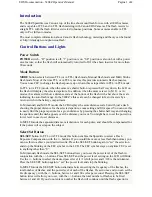
Understanding Light and Filters
FILTERS IN DIGITAL IMAGING
With all the image manipulation possibilities in digital imaging, the need for using fi lters on
the camera has been reduced. This is true especially regarding fi lters used for changing colors
or producing special effects. The correct or desired colors in any type of light are achieved
with the white balance control in digital cameras or digital sensor units (discussed in detail in
Chapter 5). Regarding special effects, the computer offers practically unlimited creative pos-
sibilities that you could only dream about a few years ago. You can create these new images
from a comfortable chair in your studio or home without destroying the original image.
However, as with everything in digital photography, some fi lters still offer a simple solution
for changing or improving images while they are produced in the camera and in some cases
provide the only simple solution to create the desired results. I therefore suggest that you still
consider using some fi lters on the camera whenever you feel that they can produce a more
effective image. This approach can eliminate time-consuming and diffi cult work on the com-
puter. If the results from the fi lter on the camera are not to your complete satisfaction, you
can always add additional improvements in the computer.
Filters Worth Considering in Digital Photography
Polarizing fi lters still offer a simple solution for improving the rendition of distant areas in
an outdoor photograph; to eliminate refl ections from glass, water, and other surfaces, and to
improve the color saturation and/or contrast in sidelighted subjects or scenes and in copying.
You may also run into situations where you want to reduce the amount of light reaching
the sensor to use a longer shutter speed or to take a picture on a sunny day with the aperture
wide open. Neutral density fi lters on the lens can do this without changing the colors when
you take the picture. I still like Softars fi lters as they produce a beautiful soft touch while
maintaining the sharpness in the image.
Partial fi ltering when taking the picture is still a good approach for darkening specifi c
areas within the composition, and is most often used for darkening bright sky areas with-
out darkening the rest of the image. In digital imaging you can darken a bright sky area and
increase the contrast range in the computer or by taking two pictures, one exposed for the
darker and one for the brighter areas within the composition and then combine the two.
17
Содержание Digital Camera
Страница 1: ......
Страница 2: ...The Hasselblad Manual ...
Страница 3: ...This page intentionally left blank ...
Страница 13: ...This page intentionally left blank ...
Страница 165: ...Heidi Niemala Editorial photograph made with a 50mm lens in the basement of a pre Civil War building ...
Страница 166: ...Heidi Niemala Photographed for clothing designer with a 150mm lens ...
Страница 167: ...Heidi Niemala Editorial portrait with a 150mm lens ...
Страница 168: ...Heidi Niemala Photographed with a 50mm lens during a sand storm at White Sands ...
Страница 198: ...Jonathan Exley An attention creating image of mult time Indianapolis 500 winner Helio Castroneves ...
Страница 200: ...Jonathan Exley Lifestyle Designer Kathy Ireland Courtesy of kathyireland com ...
Страница 243: ...Marco Grob Singer Alvin Chea from theTake 6 band photographed with an HC 2 8 80mm lens on an H camera ...
Страница 244: ...Marco Grob A make up test shot made with an HC Macro 4 120mm lens on an H camera ...
Страница 247: ...Marco Grob The Stairs photographed in CapeTown for Glamour magazine with an HC 3 5 50mm lens on an H camera ...
Страница 312: ...Raya High jewlery photograph produced with an HC 3 2 150mm lens on an H camera Raya Photographer ...
Страница 381: ...366 THE HASSELBLAD MANUAL Chart A2 Area coverage in inches with single extension tubes for the 6 4 5 film format ...
Страница 383: ...368 THE HASSELBLAD MANUAL Chart A4 Area coverage in inches with single extension tables for the 33 1 44 2 sensor ...
Страница 385: ...370 THE HASSELBLAD MANUAL Chart A6 Area coverage in inches with combinations of tubes for the 6 4 5 film format ...
Страница 387: ...372 THE HASSELBLAD MANUAL Chart A8 Area coverage in inches with combinations of tables for the 33 1 44 2 sensor ...
Страница 397: ...Chart D Close up charts for 80 to 250mm Hasselblad lenses an 503 and other V system SLR cameras based on the film format ...
Страница 398: ...Close Up Photography on Film or Digital 383 ...
Страница 400: ...Jonathan Singer ...
Страница 401: ...Jonathan Singer ...
Страница 421: ...This page intentionally left blank ...
Страница 431: ...This page intentionally left blank ...
















































